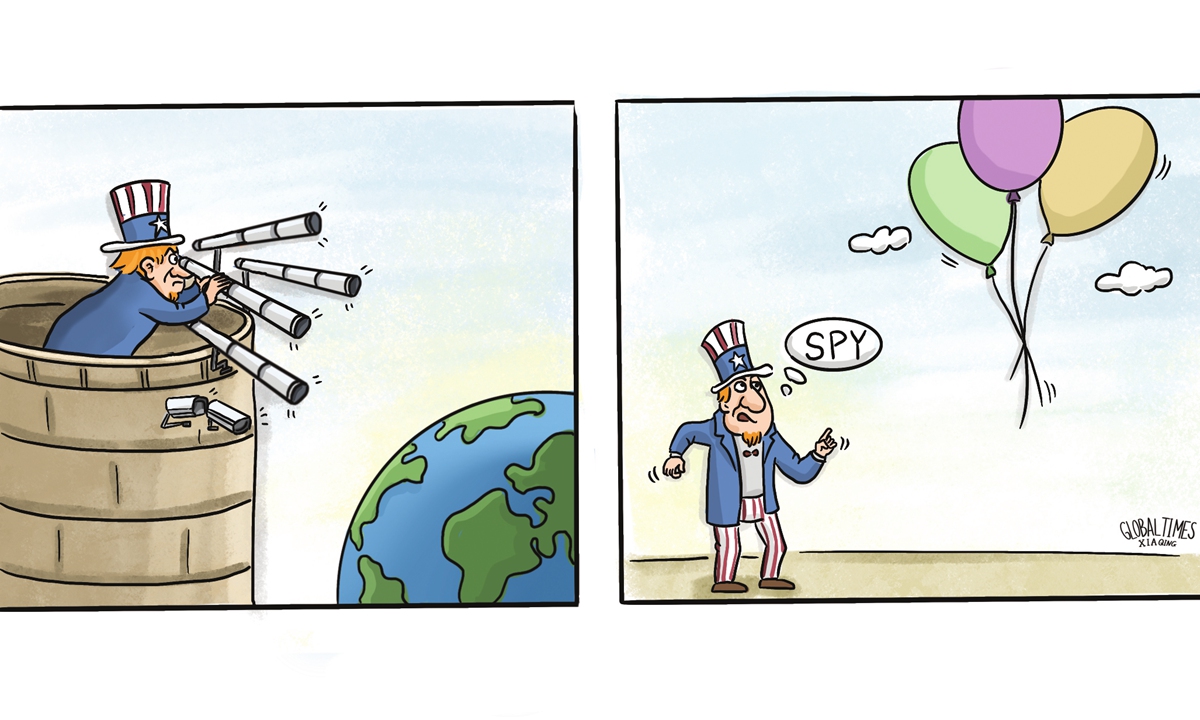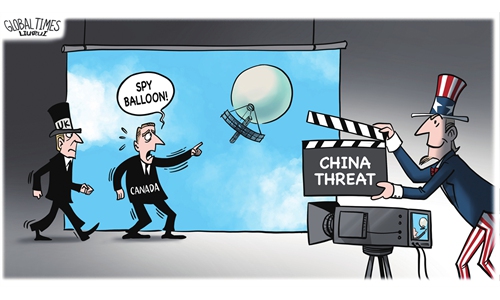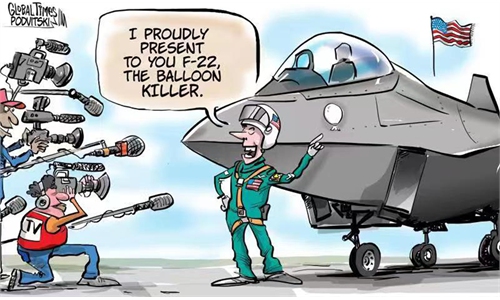
Illustration: Xia Qing/Global Times
The news of a Chinese high-altitude balloon in US airspace has been hyped up by the government as an outrageous violation of US sovereign airspace. Fighter jets were directed to shoot down the allegedly threatening device and three other unidentified objects. Many pundits contend that the balloon's airspace transit was even "an act of war." Ironically, the White House acknowledged on Tuesday that the three still-unidentified aerial objects shot down by the US in the past week likely had merely a "benign purpose."But the public shock generated intentionally took advantage of short national memories. It was in fact the US who pioneered modern global surveillance, and set the precedent for routine overflight of nations with which it was not at war.
The end of WWII marked the beginning of the Cold War. Once the Soviet Union was in possession of nuclear weapons, the US no longer enjoyed a military monopoly. Surveillance of Soviet advances in rocket and aircraft delivering nuclear weapons became critical to the US national security. German breakthroughs in rocketry were copied by both WWII victors.
It is common knowledge that the US set the precedent for sovereign airspace violations with the U2 reconnaissance aircraft. For a time, the U2 enjoyed invulnerability to Soviet radar-guided anti-aircraft missiles and interceptors at 70,000 feet. But Soviet technology closed the gap and in 1960 a U2 was shot down over Soviet territory and its pilot Gary Powers was captured.
The risk of losing another manned reconnaissance platform and its crew was seen as an unreasonable risk. Unfazed by international criticism of its violations of foreign sovereignty, the US determined that its national security interests trumped any aerospace rules of the road.
Instead, open sources reveal that the US developed a mothership-launched drone known as the D-21 capable of flying at 90,000 feet using technologies available in the 1960s. The unmanned reconnaissance aircraft was Mach-3+ capable and able to outrun and outclimb all missiles and aircraft of its day.
The D-21 was still considered experimental when the US began to employ it operationally. Four were flown over People's Republic of China (PRC) territory in the late 1960s and early 1970s. All missions were deemed failures for various reasons.
Early on a D-21 caused a fatal mishap when it collided with its mothership. It is noteworthy that the US not only elected to routinely overfly sovereign Chinese territory, but employed an unreliable Mach-3 drone with little regard for the safety of Chinese citizens on the ground. The unmanned technologies of the 1960s proved too immature, so the US returned to manned reconnaissance missions with the Mach-3+ SR-71 high altitude reconnaissance jet. For over a decade the US overflew the territories of foreign sovereign territories at 85,000+ feet with impunity. The SR-71 flew too fast and too high for competitor missiles and interceptors.
But, as with the U2, the Soviets again closed the gap with the manned Mach-3+ MIG-31 interceptor. Open sources reveal that in 1983 two MIG-31s downed a SR-71 over Siberia, and its crew members were captured. Advanced space surveillance capabilities permitted the SR-71 to be finally retired in 1998 while its successor was developed. The publicly revealed U2, D-21, SR-71 and their assigned missions were all once shielded from the public during development and execution.
A neutral observer might observe that the US precedent for violations of competitor airspace sovereignty may not place it on solid ground in criticizing other countries today.
As for the military employment of high altitude balloons the US was also a pioneer. Public sources document that years before China detonated its first nuclear weapon the US was suspending nuclear weapons beneath high altitude balloons in tests and lofting them to 80,000+ feet before detonation.
Fortune Magazine recently reported the US Army intends to field high-altitude balloons for surveillance missions. Public sources show the Pentagon has programmed $27 million in fiscal year 2023 for balloon-related projects aimed at operationalizing stratospheric platforms for a variety of military purposes. The US would be the first to admit that great powers require both world class science and intelligence programs to protect their interests. It would also agree that these alone should not lead to conflict. We should not demonize competitors from employing technology sensibly for science or in defense of their national security priorities.
Unfortunately, the US' misleading practice of "do as I say, and not as I do" is the very definition of the type of hypocrisy that could lead to war if the public is not fully informed.
The author is a retired Marine Corps infantry officer and a former Pentagon employee. Opinions are of the author and do not represent the US government. opinion@globaltimes.com.cn



